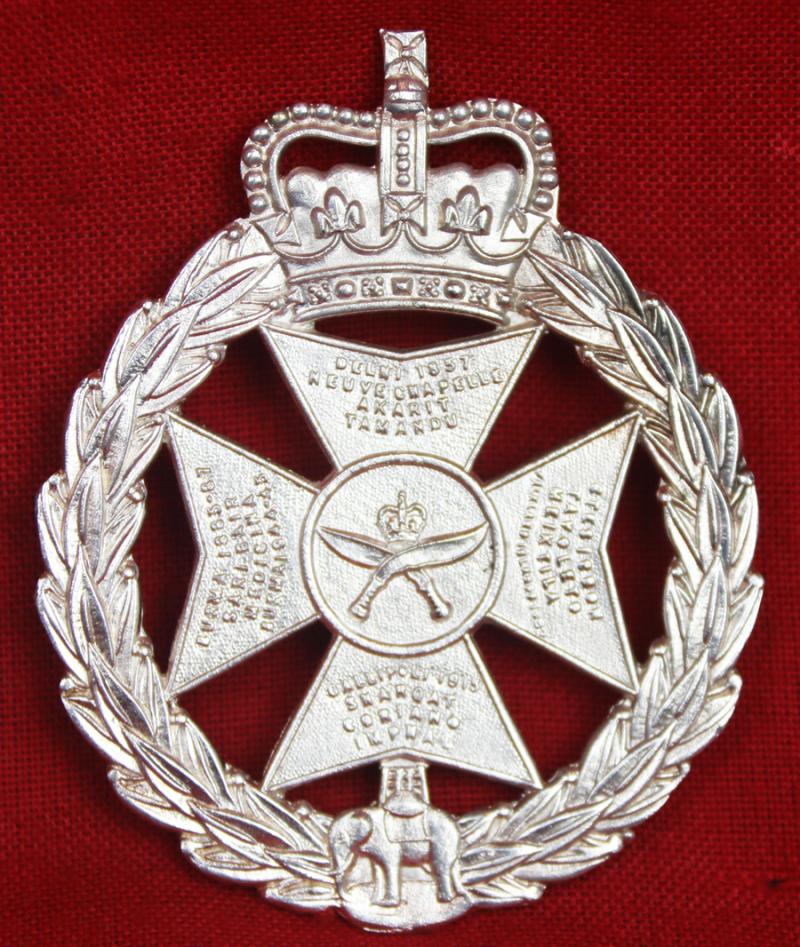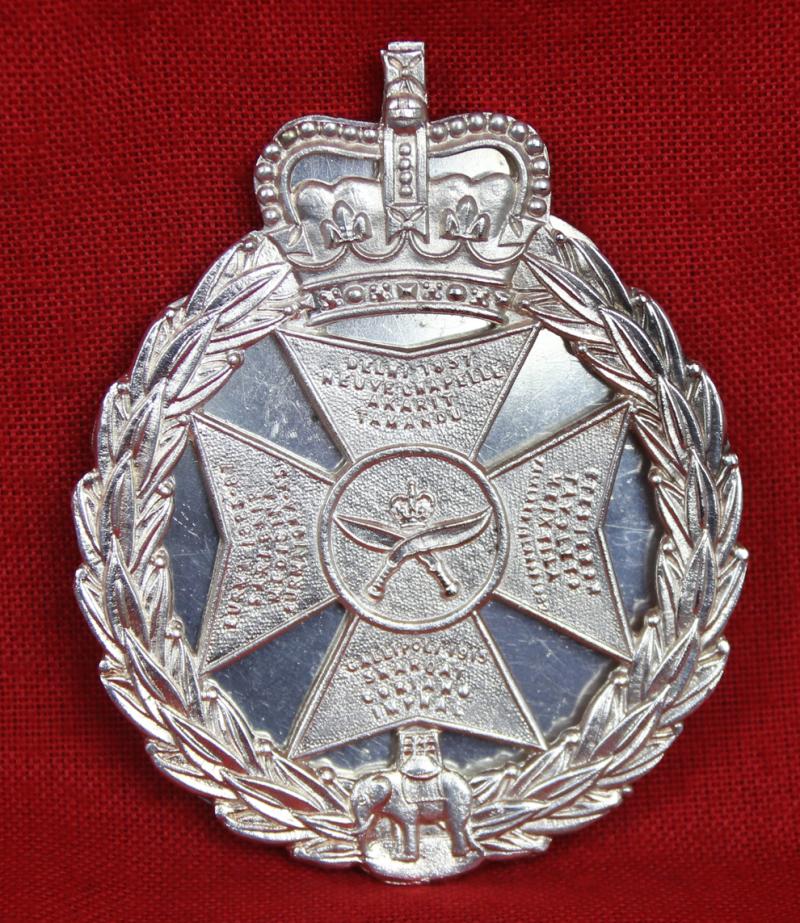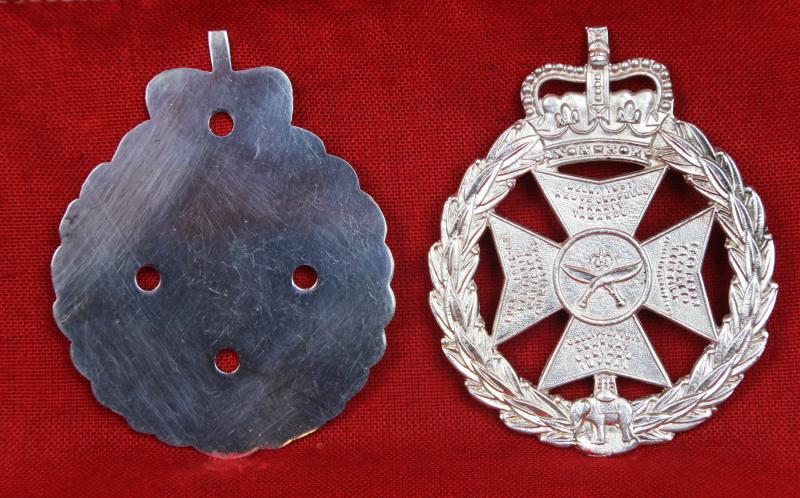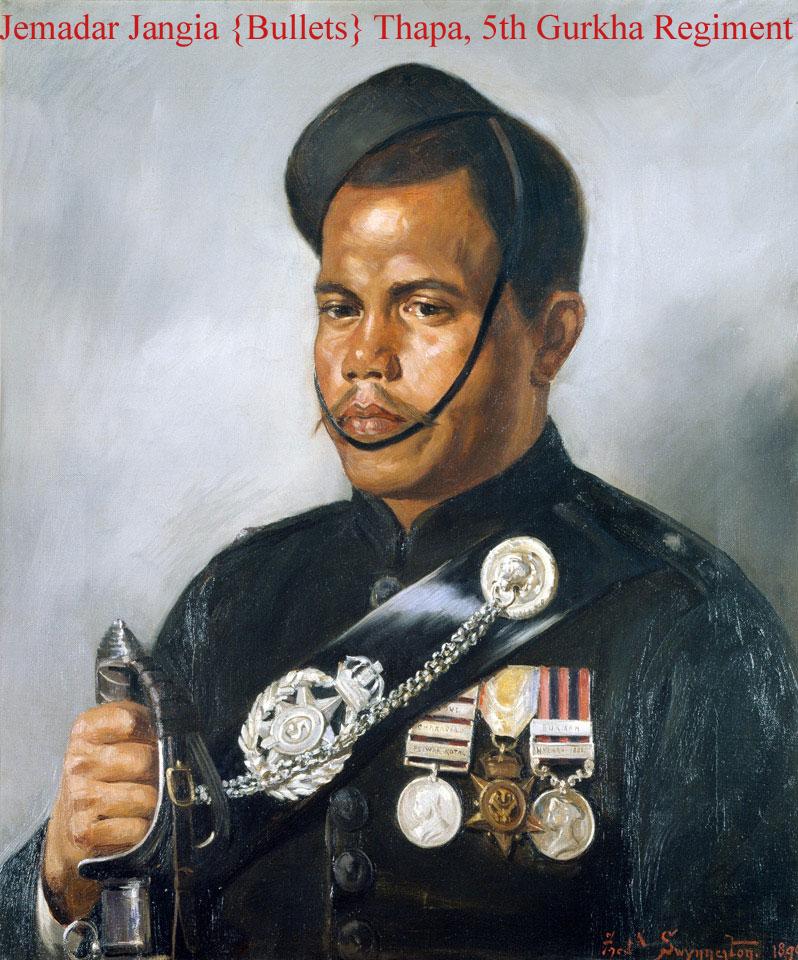Royal Gurkha Rifles, Pouch Belt Badge & Plate - Silver Plate "Come and fight a Gurkha!" Gurkha Lachhiman Gurung VC Who Single Handedly Fought Off & Beat 200 Japanese With One Hand Blown Off & Blinded in 1 Eye By Grenade
Considered to be one of the greatest and bravest regiments in the world. The very finest men to fight alongside, and the very, very worst to fight against.
"Ayo Gorkali" the battle cry of the Gurkhas, "The Gurkhas Are Coming", has been known to instill terror in any confronted enemy of the Gurkhas. Many battle hardened Japanese infantrymen in WW2, and Argentinian soldiers in The Falklands were known to have run and fled or surrendered immediately upon that battle cry being heard.
The Royal Gurkha Rifles (RGR) is a rifle regiment of the British Army, forming part of the Brigade of Gurkhas. Unlike other regiments in the British Army, RGR soldiers are recruited from Nepal, which is neither a dependent territory of the United Kingdom nor a member of the Commonwealth.
Just one example of Gurkha heroism is Corporal Dip Prasad Pun of the 1st battalion (1 RGR) was awarded the Conspicuous Gallantry Cross for an act of bravery during the War in Afghanistan in 2010. He alone defended his outpost against a force of up to 12 Taliban fighters. He fired more than 400 rounds, 17 grenades, and one mine. He resorted to fighting with his machine gun tripod after his ammunition had run out
The battle honours of the Royal Gurkha Rifles are as follows:29
Amboor, Carnatic, Mysore 1792, Assaye 1803, Ava 1852, Burma 1885–87, Bhurtpore, Aliwal, Sobraon, Delhi 1857, Kabul 1879, Afghanistan 1878–80, Kandahar 1880, Tirah, Punjab Frontier, Afghanistan 1919
First World War: La Bassée 1914, Festubert 1914–15, Givenchy 1914, Neuve Chapelle, Aubers, Loos, France and Flanders 1914–15, Egypt 1915, Tigris 1916, Kut al Amara 1917, Baghdad, Mesopotamia 1916–18, Persia 1918, Baluchistan 1918, Helles, Krithia, Suvla, Sari Bair, Gallipoli 1915, Suez Canal, Egypt 1915–16, Khan Baghdadi, Mesopotamia 1916–18, Persia 1916–1918, North West Frontier India 1915–17, Egypt 1915, Megiddo, Sharon, Palestine 1918, Shaiba, Kut al Amara 1915–17, Ctesiphon, Defence of Kut al Amara, Baghdad, Sharqat, Mesopotamia 1915–18
The Second World War: Tobruk 1942, El Alamein, Akarit, Tunis, Cassino 1, Poggio Del Grillo, Gothic Line, Tavoleto, Coriano, Santacangelo, Monte Chicco, Bologna, Medicina, Italy 1944-45, Jitra, Slim River, Sittang 1942, 1945, Kyaukse 1942, 1945, North Arakan, Imphal, Tuitum, Bishenpur, Tengnoupal, Shwebo, Kyaukmyaung Bridgehead, Mandalay, Myinmu Bridgehead, Fort Dufferin, Meiktila, Irrawaddy, Rangoon Road, Chindits 1943,44 & 45, Tamandu, Maymyo
Falklands War.
Picture 8 in the gallery is of Jemadar Jangia Bullets Thapa, 5th Gurkha Regiment, 1890
One of Major-General Frederick Roberts's orderlies during the 2nd Afghan War (1878-1880), Jemadar Jangia Thapa was nicknamed 'Bullets' because regimental tradition had it that he had once been hit on the forehead by a bullet which had been completely flattened without causing him the least discomfort. Thapa was admitted to the Second Class of the Order of British India in April 1897 and was selected as one of the representatives for India at the inauguration of the Australian Commonwealth in January 1901.
One of the most famous Gurkhas in the British Army
Lachhiman Gurung VC ( 30 December 1917 – 12 December 2010) was a Nepalese–British Gurkha recipient of the Victoria Cross, the highest and most prestigious award for gallantry in the face of the enemy that can be awarded to British and Commonwealth forces. He is best known as the "Gurkha who took on 200 soldiers with only one hand" because of his actions in World War II.
On 12/13 May 1945 at Taungdaw, Burma now Myanmar, Rifleman Lachhiman Gurung was manning the most forward post of his platoon which bore the brunt of an attack by at least 200 of the Japanese enemy. He hurled back two hand grenades which had fallen on his trench, but the third exploded in his right hand after he attempted to throw it back, blowing off his fingers, shattering his arm and severely wounding him in the face, body and right leg. His two comrades were also badly wounded but the rifleman, now alone and disregarding his wounds, loaded and fired his rifle with his left hand for four hours (all while he screamed "Come and fight a Gurkha!"), calmly waiting for each attack which he met with fire at point blank range.
His citation in the London Gazette ends with...
...Of the 87 enemy dead counted in the immediate vicinity of the Company locality, 31 lay in front of this Rifleman's section, the key to the whole position. Had the enemy succeeded in over-running and occupying Rifleman Lachhiman Gurung's trench, the whole of the reverse slope position would have been completely dominated and turned.
This Rifleman, by his magnificent example, so inspired his comrades to resist the enemy to the last, that, although surrounded and cut off for three days and two nights, they held and smashed every attack.
His outstanding gallantry and extreme devotion to duty, in the face of almost overwhelming odds, were the main factors in the defeat of the enemy.1
He received his Victoria Cross from the Viceroy of India, Field Marshal Lord Wavell at the Red Fort in Delhi on 19 December 1945
Four threaded mounting screw posts, with two affixing rounded nuts present.
93mm x 75mm
Code: 24442
140.00 GBP




